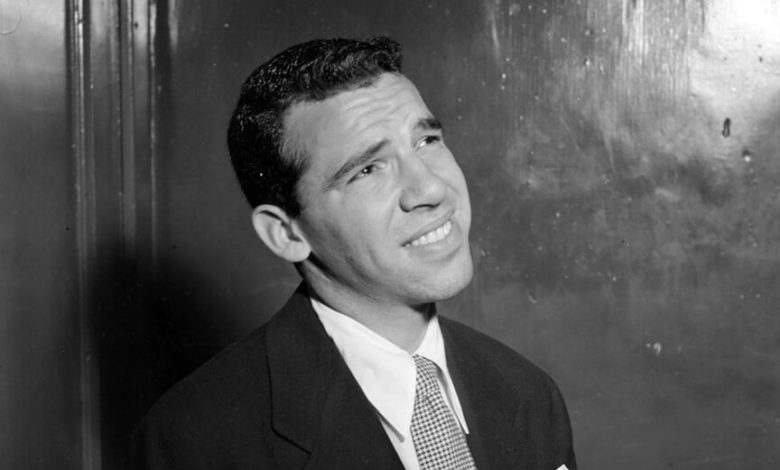
The greatest of the greats
If you’re a drummer and you haven’t heard of Buddy Rich, you’re most likely living under a rock. He is arguably the most famous drummer of the twentieth century. Most, if not all, of our favorite players were inspired by his musicality and prowess.
Other jazz greats of the time include Elvin Jones, Art Blakey, Philly Joe Jones, Joe Morello, Max Roach, and many others.
While wearing the belt of “most famous drummer,” Buddy also achieved the title of “the world’s greatest drummer” as we’ve heard time and time again.
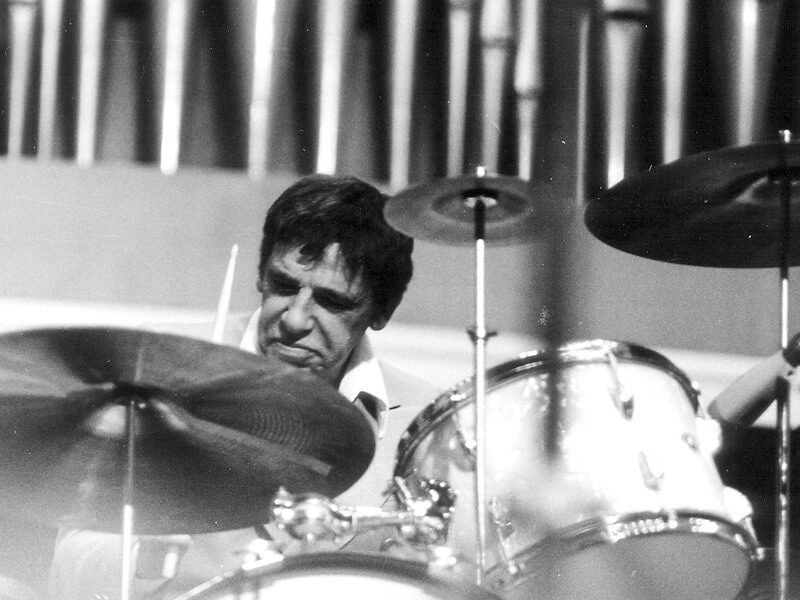
We’ve seen his drum solos, impressive one-handed rolls, sheer power, and speed during performances. He was a master of rudiments. There truly wasn’t anyone like him and hasn’t been since his death.
His loyalty to the music and art of performance is what sets Buddy apart from many other drummers of the time. Fearless is a perfect adjective to describe his overall vibe.
He’s been honored all over media and pop culture. In 2017, Palm Springs Walk of Stars awarded Buddy his own Star. Buddy was also named No. 15 in Rolling Stone magazine’s 100 Greatest Drummers of All Time.
After his death in 1987, Rush drummer/lyricist Neil Peart produced two tribute albums featuring performances of great rock and jazz drummers alongside the Buddy Rich Big Band.
My first time seeing Buddy Rich play was the video I’ve linked below. I was blown away by the sheer ability and technical dominance displayed in his performance. It’s truly unbelievable.
Early life
Buddy had an interesting upbringing that can almost be paralleled to the Disney child stars of today (but in a good way).
He was born on the 30th of September in 1917 to Bess Skolnik and Robert Rich. Before they knew it, he was emulating playing the drums with a fork and knife.
Young talent
Buddy’s parents were vaudevillian performers and he soon became a part of their act, even before turning two. In between breaks during shows, he would attempt to sneak to into the orchestra pit to beg for the drummer’s sticks.
A child prodigy is putting it lightly for young Bernard. By four years old, he was known on Broadway as Baby Traps the Drum Wonder. “Stars and Stripes Forever,” the classic
John Philip Sousa march, was Buddy’s hit song. He would play along to the march on a snare drum.
Before Buddy was sixteen years old, he was already the second highest paid young entertainer in the industry, making $1,000 a week. That may not seem like much in today’s standards, but consider inflation.
Drumming career
It wasn’t until Buddy was twenty years of age that his career would begin. His first major jazz group to perform with was led by clarinetist Joe Marsala.
He then went on to become a regular member of big bands led by Bunny Berigan and Artie Shaw in the late thirties.
Interestingly enough, during his time off of touring, Buddy gave lessons to a then 14-year-old Mel Brooks for half a year. He was fortunate enough to have been in a class with his brother Mickey.
Buddy’s first major recorded performance was with the Vic Schoen orchestra when he was just twenty-one.
1938 was a special year, as he was recruited to play in Tommy Dorsey’s orchestra, leading to a great relationship with famous singer Frank Sinatra.
Military service
During the early forties, Rich would enlist in the United States Marine Corps during the height of World War II.
During this time he was a judo instructor and coauthored the popular method book Buddy Rich’s Modern Interpretation of Snare Drum Rudiments.
Despite his time in the USMC during WWII, Buddy never did serve active duty.
In 1944, Buddy was discharged from the military due to medical reasons. Upon his release, he was back at it playing with the Dorsey band once again.
His “own” band
In 1946, Frank Sinatra provided financial support for Buddy to start his own band. Rich would continue to lead different big band groups until the early fifties.
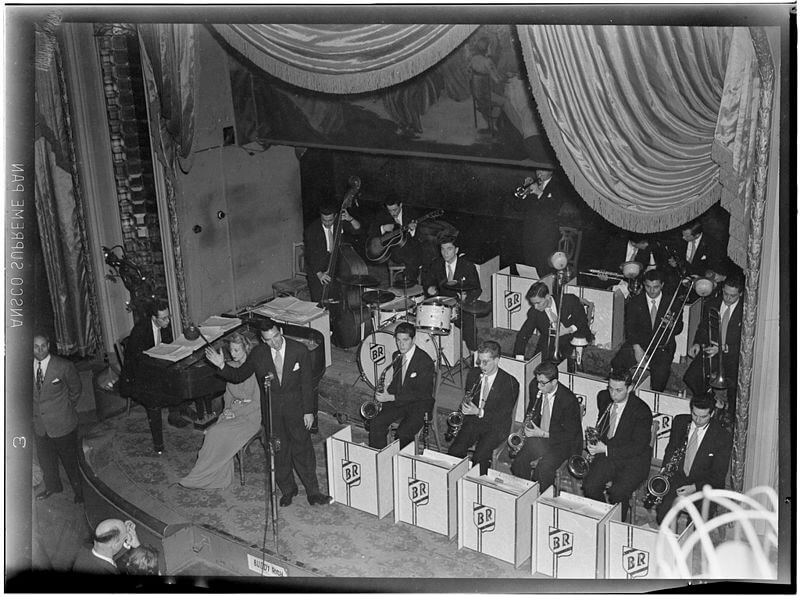
Between the forties and the mid sixties, Buddy played with tons of fantastic musicians including Benny Carter, Harry James, Les Brown, Charlie Ventura, Charlie Parker, Dizzy Gillespie, and Thelonious Monk.
Buddy was featured on a Charlie Parker and Dizzy Gillespie album appropriately titled Bird and Diz in 1950. Max Roach also performed on the album.
During this time, Rich was a seasoned guest on The Steve Allen Show and plenty of other variety shows. Another being The Tonight Show with Johnny Carson.
To his personal life, Buddy married his wife, Marie Allison, in the spring of 1953. Just a year later, she would give birth to their only child, Cathy. At this point in Buddy’s career, he is reportedly the highest-paid sideman in the world making $1,500 a week.
A year later, Buddy would appear on an awesome album entitled Krupa and Rich. “Bernie’s Tune” is the only track that features both drummers simultaneously; there’s a six-minute drum battle between the two. It’s fantastic.
Just a few short years later, Rich would suffer his first heart attack. Unfortunately, it wouldn’t be the last time Rich would deal with heart issues.
The decline of “big band”
For many jazz and big band players of the mid-sixties, their careers were waning. Big band music peaked in popularity during the 30s and 40s. Rock and roll was the newest thing. It was fresh and different. People were tired of jazz and swing.
That being said, Buddy’s popularity managed to stay alive as he managed to lead successful big bands up until his death, despite the downward trend.
During this period, Rich stated that most of the gigs he played were in high schools, colleges, and universities. Club performances were far and few between.
Despite the decline in popularity of style, Buddy pushed on, ensuring that people needed to hear true musicianship. He shared that with all of us until the day he left.
His 1966 album, Swingin’ New Big Band, features a fantastic arrangement of West Side Story that features Rich in a spectacular fashion. The way he was able to meld the composition into his drumming style is wonderful.
The video above shows a live performance of the piece from 1982. I still to this day cannot get over how smooth Buddy is when he plays. The solos are incredible.
The 1970s
By the mid-70s, drummers knew all about Buddy Rich, finally. His performance at the Top of the Plaza in Rochester, New York was broadcasted on PBS TV to thousands of budding, young drummers. This was one of the first TV performances broadcasted in full of Rich’s band.
Buddy opened his own club in New York called Buddy’s Place. Fitting. Subsequently there after, he was featured on the cover of the debut issue of Modern Drummer magazine. Talk about an honor!
Just a few years later, he would be inducted into the Modern Drummer Hall of Fame.
Muppets
Who can forget the drum battle between Buddy Rich and the Muppet character Animal? Rich appeared on an episode of The Muppet Show in 1981.
Jim Henson pointed out to Buddy that out of all the shows they had done, the episode with Buddy was one of the best.
Rich had done plenty of other television appearances prior, but this one is probably the most widely seen.
Death
Buddy played all the way up until his final days. He was touring in New York when he was hospitalized after noticing symptoms of a heart attack.
Physicians believed Rich had suffered a stroke and he was transferred to UCLA Medical Center for testing where doctors removed a brain tumor.
Unfortunately, after the procedure just a few weeks later, Rich suffered a sudden cardiac failure. He was 69.
Legacy
Despite his death being a bit early, Rich left us a wealth of drumming knowledge and played music to the end that he truly believed in.
Despite being rough around the edges, I’m sure he could be earnest and sincere. The famous tirade on the band bus is one moment I’m sure he wasn’t proud of.
The level of personal integrity in his music speaks volumes. I may never have seen him perform or met him, but I appreciate everything I have learned from him thus far.
In 2012, Modern Drummer readers voted Buddy Rich the greatest drummer of all time. He truly was one of a kind.
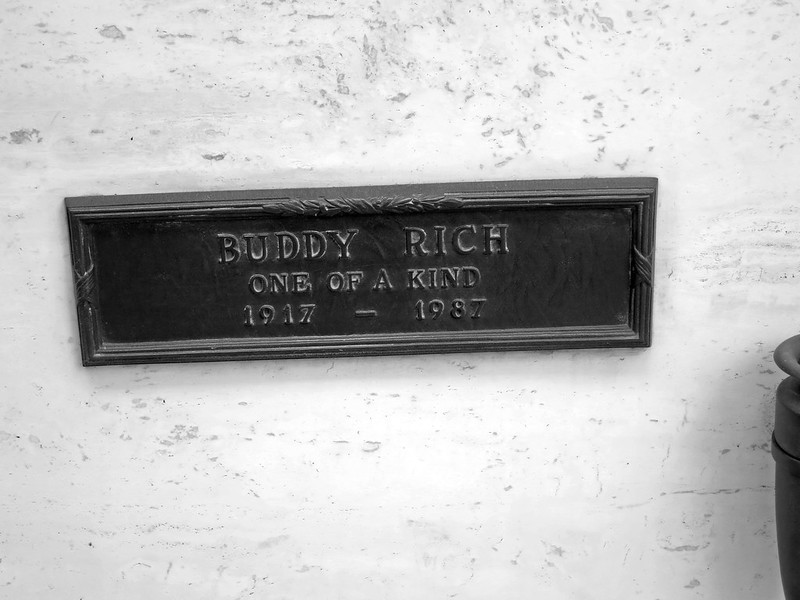

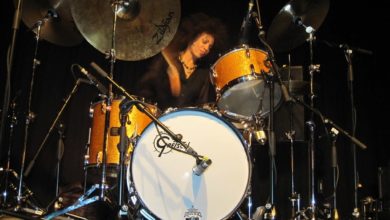
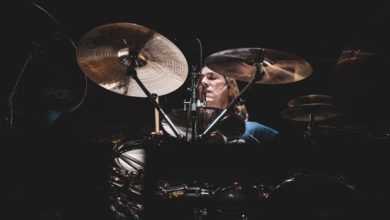
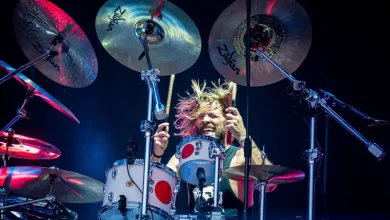

According to some Rich band members, those tapes with him yelling at his band…they deserved to get yelled at. Evidently some of the young band members messed up .
0
Tell the whole truth, Buddy Rich was DISHONORABLY DISCHARGED from the U.S.M.C.
0
Cite your source you jealous hack.
0
While the style has changed in modern jazz and rock drumming and there are a lot of awesome drummers today, I have yet to hear anyone with BRs smoothness and endurance. He could keep up a 10 min solo and be as fast at the end as the beginning. For a mostly trad grip drummer, his left hand was truly phenomenal
0
What Club did Buddy Rich play at in Downtown Chicago ,on Randolph & State St,,between 1957 & 1960. Irv Kupcinet & Essie ,use to watch him. My in date and I went there often to see him ?
0
We serious drummers should not forget Buddy’s peer, the redoubtable drummer and composer/ arranger Louis Bellson, whom Buddy held in so much esteem that he once asked Louis to sit in with his, Buddy’s, band while he was healing from a fracture in one of his arms.
Among the innumerable fantastic more- current drummers, are Steve Gade (spelling ?), Carl Palmer, and Billy Cobham.et al. ADDENDUM: Joe Morello
0